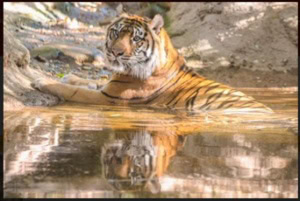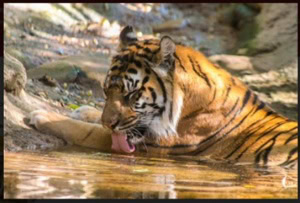“Will our tiger last the decade? / To our children, ancient history?”
These are the frightening questions Mike Jones asks in his poem, Sumatran Tiger (Jones, lines 11-12). Over the past century, tiger populations have first declined, then increased. Why do the populations fluctuate and what are some of the current threats and challenges that they still face today?
In the early 1900s, there were nine subspecies of tigers that used to roam the earth throughout Asia consisting of around 100,000 individuals. Unfortunately, three of these subspecies are now extinct: Bali, Caspian, and Javan. The surviving six subspecies include the Amur (Siberian), South China, Indochinese, Malayan, Bengal, and Sumatran tigers. The smallest subspecies of tiger, the Sumatran tiger, can often be seen at your local zoo!

Why did three tiger subspecies become extinct?
The decline of the Bali, Caspian, and Javan subspecies was a result of habitat loss, poaching, retaliatory killings (human-wildlife conflicts), and black market tiger trafficking (selling tigers for cub petting, skins, bones, etc.). Tiger parts have been used in traditional Chinese medicine for centuries and have been thought to aid in other purposes through folklore. For instance, tiger whiskers are worn as protective charms or used to soothe toothaches. Additionally, tiger bones are used to treat ulcers, typhoid, malaria, dysentery, burns, and rheumatism, or are made into a wine to aid other ailments.
According to the World Wildlife Fund (WWF), over the last 100 years, tigers have lost 95% of their historical range and their population has declined 97%. These animals are losing their habitat as a result of human activity and encroachment, including logging and unsustainable palm oil production. Palm oil is the most widely consumed vegetable oil on the planet, and is found in many products found at your local grocery store from ice cream to shampoo to biodiesel.
Of course, these are all issues that tigers are still facing today. Furthermore, scientists have estimated that there were as few as 3,200 wild individuals in the last ten years. However, their numbers are slowly starting to increase globally thanks to conservation education, research, and community involvement. Due to raised awareness and conservation efforts, there are close to 3,900 tigers in the wild today. However, our work is not finished.
What would happen if all tigers became extinct?
It would be very problematic for other species as well as humans. Tigers are apex predators, which means that they are extremely crucial to the environment. They also serve as a keystone species meaning they are an animal that preserves the balance of nature in our ecosystems. Without these important species, the environment would greatly suffer from prey population explosions, overgrazing, disease, and more.

Did you know that there are estimated to be 10,000 big cats in captivity? That is three times more than there are in the wild! This includes lion, tiger, leopard, cheetah, jaguar, or cougar species, and any hybrid of such species. Unfortunately, these majestic animals sometimes fall into the wrong hands, as shown in the true crime documentary, Tiger King. In some unaccredited institutions, tigers are used strictly for profit and can include tiger selfies or other photo opportunities, ripping tiger cubs away from their mothers so guests can hold them, and other animal exploitation methods.
If these large felines are not found in reputable or accredited institutions, then they may be subject to animal abuse such as cub petting, declawing, malnourishment, etc. Until recently, there was no form of federal protection for these animals regarding private ownership and exploitation. Reputable facilities, like AZA (Association of Zoos and Aquariums) and GFAS (Global Federation of Animal Sanctuaries) institutions, practice the highest standards of animal welfare and are crucial for conservation advancement. Additionally, AZA facilities participate in a SSP (Species Survival Plan) where they manage ex-situ (“off-site”) populations to promote healthy, sustainable, genetically diverse, and demographically varied AZA populations.
In December of 2022, President Joe Biden signed the H.R.263/S.1210 Big Cat Public Safety Act into federal law. This law entails the following: prohibits private ownership of big cats, makes it illegal to buy, sell, trade, or transport big cats across state lines without a permit, and prevents the public from direct contact with big cats (including cubs). Because of this law, big cats are now protected from multiple forms of animal abuse. Not only that but since big cats are banned from being privately owned, this lessens the opportunity for international black market trade. This legal leap is an incredible feat for big cat conservation, however, the law alone is not enough to save these majestic animals.
“Spring to action like the tiger / Planting trees and education / Guardians all of unique creatures / We can save the Sumatran tiger” (Jones, lines 15-18).
When facing conservation obstacles, the most powerful strategy we have to inspire positive change is through global awareness, education, and action. Jones reiterates this message in his poem. How do we accomplish this? Below are a few techniques on how to play your part in big cat conservation!
How Can I Help?
Visiting a Zoo or Sanctuary
- Know how to do your research and ask questions! A good first step would be to check if the facility you are going to is either AZA (Association of Zoos and Aquariums) or GFAS (Global Federation of Animal Sanctuaries) accredited
- These are two highly renowned accreditations that uphold the highest animal welfare standards
Spread the Word!
- Watch what you follow and share on social media
- Be ethically conscious and exercise due diligence on animals
Practice Daily Conservation Efforts
- Raise awareness of big cat conservation
- Use sustainable palm oil to preserve tiger habitats – Cheyenne Mountain Zoo PalmOil Scan App
- Support Roundtable for Sustainable Palm Oil (RSPO) which creates standards for sustainable palm oil production and certifies qualified growers and processors
- Be aware of products bought internationally and know what to ask to help stop poaching and promote ethical tourism (e.g. Is this real tiger fur?)
- Donate to big cat conservation organizations and efforts (e.g. Panthera and WWF)
With your help, we can live in a world where tiger populations are protected in the United States, conserved in the wild, and the balance of their ecosystem restored.
![]()
Allie Coronado, Miami University Graduate Student
Allie Coronado works as a Community Engagement Coordinator at Best Friends Animal Society and a Softball Pitching Instructor at Cherokee Batting Range. She is a graduate student in Project Dragonfly’s Global Field Program at Miami University in Oxford, Ohio.
I would like to thank Beckie Moore, who previously worked at Turpentine Creek Wildlife Refuge as their Education Department/Wildlife Coordinator, for allowing me to interview her and find some of the most impactful ways that the public can help big cats. Thank you Sharyn Umana-Angers, Sarah Sherwin, Dani Hopper, and Martha Loizeaux for helping with the peer review. The incredible photography was provided by my good friend, Shauna Dankberg, a Carnivore Animal Caretaker at Zoo Atlanta. This work was conducted as a part of graduate work through Project Dragonfly at Miami University in Oxford, Ohio. Special thanks to Dr. Deanna Soper for her support and advice.
Sources
Association of Zoos & Aquariums | AZA.org. (n.d.). Retrieved April 22, 2023, from https://www.aza.org/
Global Federation of Animal Sanctuaries (GFAS). Global Federation of Animal Sanctuaries. (2023, March 20). Retrieved April 22, 2023, from https://sanctuaryfederation.org/
Gray, T. (2021, April 1). What Does The World Gain When We Protect Tigers? WWF. Retrieved April 22, 2023, from
https://www.worldwildlife.org/stories/what-does-the-world-gain-when-we-protect-tigers
H.R.263 – Big Cat Public Safety Act 117th Congress (2021-2022). Congress.gov. (n.d.). Retrieved April 22, 2023, from
https://www.congress.gov/bill/117th-congress/house-bill/263
Jones, M. (2014). Sumatran Tiger. PoetrySoup.com. Retrieved April 22, 2023, from https://www.poetrysoup.com/poem/sumatran_tiger_540120#:~:text=Spring%20to%20act ion%20like%20the%20tiger%20Planting%20trees,Copyright%20%C2%A9%20Mike%2 0Jones%20%7C%20Year%20Posted%202014
PalmOil Scan Mobile App. Cheyenne Mountain Zoo. (2023, February 28). Retrieved April 22, 2023, from
https://www.cmzoo.org/conservation/orangutans-palm-oil/palm-oil-scan-mobile-app/
Species Survival Plan® Programs. AZA. (n.d.). Retrieved April 22, 2023, from https://www.aza.org/species-survival-plan-programs
Why Should We Save Tigers? WWF. (n.d.). Retrieved April 22, 2023, from https://www.wwfindia.org/about_wwf/priority_species/bengal_tiger/why_save_the_tigers /#
World Wildlife Fund. (n.d.). Tiger. WWF. Retrieved April 22, 2023, from https://www.worldwildlife.org/species/tiger
*Published by Allie Coronado on 10/21/2023*